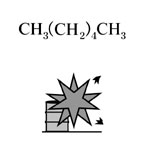| Case Name |
Explosion and fire caused due to insufficient purging during inspection work on a continuous extractor |
| Pictograph |

|
| Date |
December 22, 1991 |
| Place |
Izumisano, Osaka, Japan |
| Location |
Food factory |
| Overview |
The extractor of the extraction plant broke down. Ventilation of the extractor was started for workers to enter it for repairs. The combustible gas-air mixture was generated by hexane vapor remained in it because ventilation was not sufficient. Explosion occurred due to static electricity when the repair work started in the extractor. When workers enter vessels not only an extractor, safety should be ensured at least by detecting concentration of flammable gases and vapor , and checking oxygen concentration. |
| Incident |
The extractor of the hexane extraction plant broke down. Explosion occurred when operators went into the extractor and started repair work after ventilation. |
| Processing |
Manufacture |
| Individual Process |
Maintenance |
| Substance |
n-hexane, Fig3 |
| Type of Accident |
Explosion, fire |
| Sequence |
22:00. on December 21st, 1991. The extractor broke down.
10:00. on December 22nd. Repair work started.
13:10. Ventilation of hexane in the extractor was started for workers to enter the extractor.
14:00. Explosion occurred in the extractor as soon as work started. |
| Cause |
Due to insufficient ventilation, hexane vapor in the extractor generated combustible gas-air mixture, which was ignited due to static electricity, and exploded. Refer to Fig.2. |
| Response |
Extinguishing with water |
| Countermeasures |
Review of the manual which was reduced to a mere shell.
Review of the emergency management system in the absence of a responsible person during holidays.
Above all, what is most important is that the whole company as well as all members of the factory should share the awareness that handling a large amount of light flammables is dangerous at all times. |
| Knowledge Comment |
Despite the danger of the site, the workers seemed to be used to work ignoring the safety manual or without permission. The lessons from past accidents were forgotten because similar accidents had not happened for a long time. The first step for ensuring safety is to make good use of past experience. |
| Background |
1. The prescribed ventilation time was not observed. Operating manual was ignored.
2. Work was carried out on a holiday without permission of the superior. There seemed to be a lack of awareness that handling light hydrocarbons such as n-hexane is very dangerous. |
| Incidental Discussion |
There are many cases of explosion with extractors and centrifuges caused due to insufficient ventilation during inspection. The reasons should be examined. |
| Reason for Adding to DB |
A typical accident caused due to insufficient purging at facilities handling light flammables |
| Scenario |
| Primary Scenario
|
Poor Value Perception, Poor Safety Awareness, Inadequate Risk Recognition, Organizational Problems, Poor Management, Slackness of Management/habit, Carelessness, Insufficient Precaution, Mannerism, Planning and Design, Poor Planning, Purge Planning, Malicious Act, Rule Violation, Safety Rule Violation, Secondary Damage, External Damage, Explosion/Fire, Bodily Harm, Death, 8 person died, Bodily Harm, Injury, Loss to Organization, Economic Loss, Direct Monetary Damage 47 million yen
|
|
| Sources |
Izumisano City Fire-Defense Headquarter. Outline of Explosion at F company H factory, 1991.
High Pressure Gas Safety Inst. of Japan. High-pressure gas protection overview. pp.249-250, 254 (1992)
Kawasaki City Dangerous objects safety research association. Case of accident that is useful at present. Examples of accidents at dangerous facilities. With FTA) pp.14-16(1997).
Fire and Disaster Management Agency. Major cases of accidents. Fire and explosion under inspection work in the continuous extractor. Accident cases of dangerous materials. p32,92-95
|
| Number of Deaths |
8 |
| Number of Injuries |
1 |
| Physical Damage |
An extractor was damaged by fire at factory C. A heat exchanger and a flow conveyor were damaged. A solvent extractor was deformed. A flow meter of the absorption column was damaged by fire. Heat insulation of the distillation column was broken. A pump was scorched.
At factory B, parts of the external wall were damaged by fire. The roof of fumigation warehouse was damaged. Heat insulation of an outdoor tank storing designated flammables was damaged.
At No.1 and No.2 factories of Factory H, a measuring room and a workshop were damaged. Windows of a coastal office were damaged. 8600 liters of n-hexane, 1500 liters of liquid paraffin, 3000 liters of animal/vegetable oil, and 3910 liters of oil cake were damaged. |
| Financial Cost |
¥ 47 million. (Accident cases of dangerous materials) |
| Multimedia Files |
Fig2.FTA
|
|
Fig3.Chemical formula
|
| Field |
Chemicals and Plants
|
| Author |
WAKAKURA, Masahide (Kanagawa Industrial Technology Research Institute)
TAMURA, Masamitsu (Center for Risk Management and Safety Sciences, Yokohama National University)
|
|